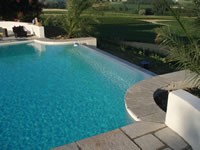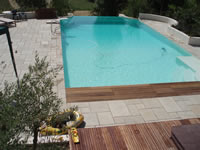Infinity Edge
&
Deck Level Pools
-
Infinity Edge Pools
Introduction
If you want an outdoor swimming pool and have a property with an interesting or even spectacular view from the garden you could seize the opportunity to substantially increase the value of your property by installing an infinity edge pool as illustrated by these pictures of a pool that Bluepools installed in France.
(Click on image to view details)
 |
 |
Film producers have used infinity edge pools to provide artificial horizons for 60 years or more and there is no doubt that swimming in these pools can be a quite magical experience when the edge appears to merge with sea in the background or even the sky if the pool is located high up on a hillside.
What is an Infinity Edge Pool?
Infinity pools are also known as vanishing edge or negative edge pools. They have one or more sides where the pool edge terminates in a weir that is about 15 mm lower than the median pool water level. The water cascades over the weir into a collection trough that runs along beneath the whole length of the weir.
The infinity edge system is only designed to run when the pool is being used and consists of an overflow system that takes water from the collection trough, filters it and returns it to the main pool whenever swimmers are using the pool.
The main filtration system works in exactly the same way as a conventional pool except that the conventional skimmers are not required and the water circulates back through the pump via the drain in the pool floor.
This means that the high capacity pump that is needed to run the infinity edge circulation system only needs to be running when the pool is actually in use - thus the running costs of an infinity pool are not a lot higher than with a conventional pool.
Increased Filtration Efficiency
The most important benefit that an infinity edge pool provides is that the overflow weir very effectively and constantly removes and filters the surface layer of pool water that contains a large proportion of the pathogens, bacteria and organic matter that exist in every pool - thus making the water look sparkling simply because it is cleaner and healthier.
Deck Level Pools
These are called deck level or mirror pools – and they do look like mirrors! The concept is based on the use of the infinity edge right round the pool perimeter and is very suitable for a normal garden without spectacular views.
The majority of the premium quality indoor pools are now being installed as deck level pools and some outdoor pools are now incorporating them.
These are an exciting option when the views from a garden are less than spectacular and the pool itself needs to be the centre of attention.
In a deck level pool the infinity edge is taken around the entire perimeter of the swimming pool and the weir is drained by a perimeter trough that is much smaller than the collection trough of an infinity pool.
The perimeter trough is drained by a network of gravity fed downpipes that take the water to a central collection tank that provides the buffer water storage normally provided by the collection trough in a conventional infinity pool. The cost of a deck level pool will be more than the cost of an infinity pool of the same size with the infinity edge along one long side.
We have found that by increasing the size of the pipework that takes the water from the overflow channels to the filter we can create the required water storage capacity in the pipes themselves - thus avoiding the need to provide a buffer tank.
II. THE COSTS
Building Costs
The additional cost of an infinity edge pool arises mainly from the provision of:
- the collection trough that acts as a buffer tank
- the water-proofing of the weir and the collection trough
- the larger capacity infinity edge circulation pump and filter
- the electronic autofill sensor in the collection trough
The automatic level sensor / filling device is needed to ensure there is enough water in the system to prime the edge pump and to compensate for any waves sent over the weir by bathers and rainwater.
For a 12 x 6 metre pool with one infinity edge, the total additional cost of an infinity pool should be in the £8,000 - 10,000 range excluding VAT. The trough and autofill, edge filtration system and the additional water proofing costs will each amount to about one third of this.
The water-proofing may seem to be costly but a conventional factory made PVC liner is not suitable for an infinity edge pool and needs to be replaced by a PVC in-situ liner system that involves cutting and welding the PVC liner on site. This is normally provided with a 10 year guarantee.
Operating Costs
The additional operating costs of either an infinity or deck level pool will not be that high because the big pump needed to run the infinity edge system will only operate when the pool is in use. The extra costs will be incurred from:
- The power the pump uses
- The cost of the water that is lost due to evaporation from the flow over the weir
- The cost of replacing the heat loss caused by evaporation
- The heat required for the water replacing the evaporated water
The total additional operating cost is difficult to assess accurately because it does depend on so many variables but it will certainly be less than the cost of heating a conventional pool of the same size using a heat pump.
III. Infinity Edge Pools are all the Rage!
The development of infinity pools has coincided with the increase in a new trend towards designer pools that are now often seen at exclusive properties and on magazine covers. Many people have property in an ideal location for the installation of an infinity edge pool even more have gardens that would benefit from a mirror pool and I hope this article encourages the development of both.
